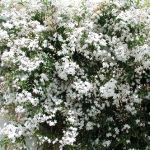| Common Name: |
Common Jasmine |
| Other Names: |
Jessamine |
| Botanical Name: |
Jasminum officinale |
| Genus: |
Jasminum |
| Family: |
Oleaceae |
| Native Location: |
Himalayas, N Iran, Afghanistan, the Caucasus. |
| Cultivation: |
Rich, well-drained soil in sun. Thin out shoots or cut back after flowering. Plants under cover may be affected by spider mite, aphids, whitefly, and mealy bugs. |
| Propagation: |
By semi-ripe cuttings in summer; by layering in autumn. Jasminum sambac "Grand Duke of Tuscany" is difficult from cuttings. |
| Harvest: |
Roots are lifted in autumn and dried for use in decoctions (J. sambac). Leaves are picked as required and used fresh or dried. Flowers are picked soon after opening each morning and used fresh for oil extraction, or dried for infusions, medicated oil, pastes and powders. |
| Varieties: |
Argenteovariegatum syn Vareigatum
Has leaves vareigated cream, and gray-green; new leaves are pink-flushed.
Aureum syn. Aureovariegatum
Has yellow-variegated leaves.
f. Affine syn. Grandiflorum
Has larger flowers with pink-tinged buds.
Frojas syn. Fiona Sunrise
Has yellow foliage. |
| Height: |
10m (30ft) |
| Hardiness: |
Z9-11 |
| Parts Used: |
Flowers, oil. |
| Properties: |
An aromatic, tonic, euphoric herb that relieves spasms, increases milk flow, and stimulates the uterus. It also has aphrodisiac and antiseptic effects. |
| Medicinal Uses: |
Mainly in aromatherapy for depression, nervous tension, impotence, frigidity, menstrual disorders, respiratory disorders of nervous origins, and weak digestion. |
| Economic Uses: |
Essential oil is used in perfumes with a floral note and in food flavorings (notably maraschino cherries). |
| Bibliography: |
Encylopedia of Herbs by Deni Brown Copyright ©: 1995, 2001 Dorling Kindersley Limited pg 245-246
|
